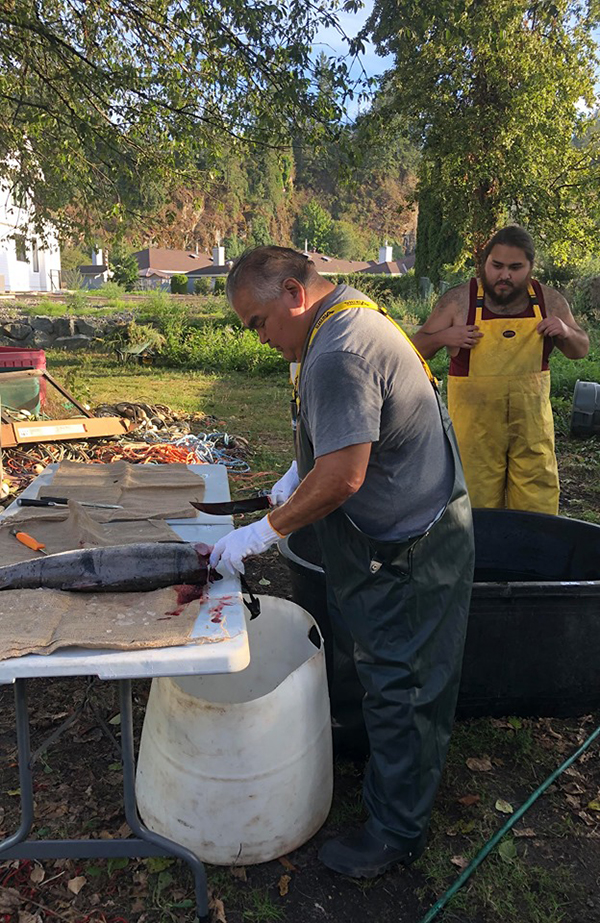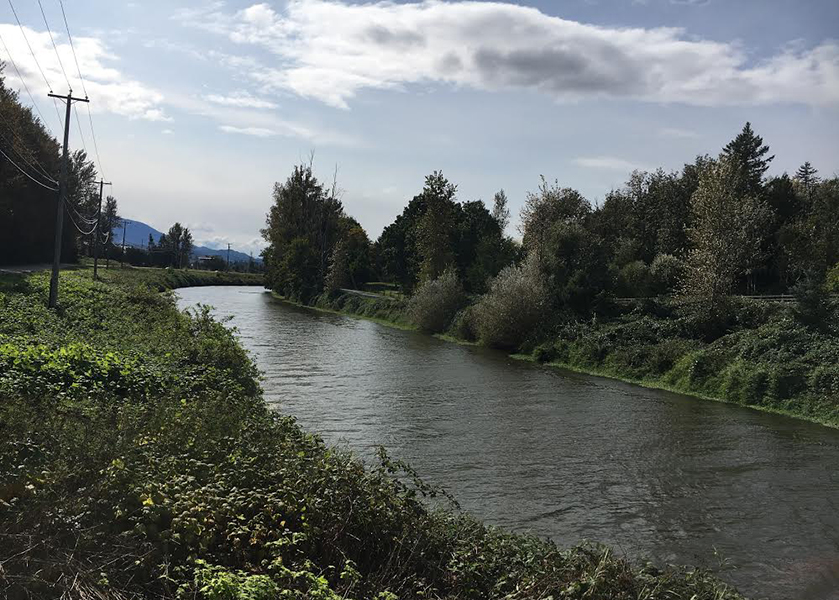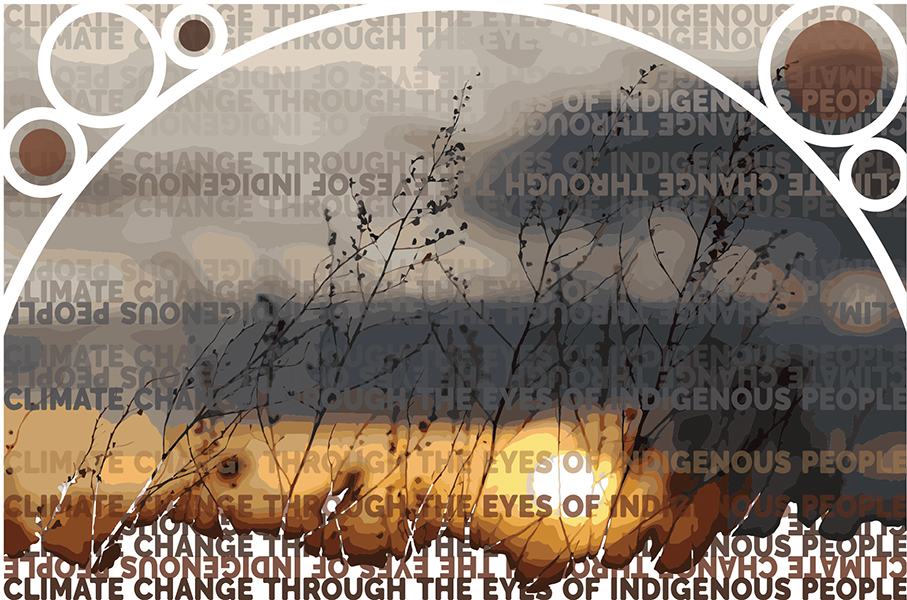Being only a quarter First Nation, I must admit my knowledge concerning Stó:lo First Nation culture relative to that of my Indigenous family members is modest at best. So, when exploring an Indigenous people’s perspective on the ongoing climate crisis, it was important for me to consult family and elders.

My grandmother, Mona Sepass, was born in 1944 and raised in Kilgard, a reserve in Abbotsford and home to Sumas First Nation. When she turned four, she was taken to Saint Mary’s Residential School and remained there until she turned 12. She later received a language proficiency certificate in Halkomelem from Simon Fraser University, married, and had five children on the Skowkale reserve in Chilliwack. She continues to work at A:lmelhawtxw (which translates into “caring for our children”) Early Education Centre, where she teaches children the Halkomelem language. She and most of her children still live on the Skowkale Reserve to this day. To explore the environmental degradation they’ve witnessed leading up to today, I asked about the biggest changes they’ve seen in our ecosystems.
When my grandmother responded with “the change of the water,” I was quite surprised, as I had a premonition that she would say something about the weather or climate. She went on to tell me that as a child, she had no running water, so her family relied on a creek that came by her pasture.
“There was fish in it [that] we could just go pull out and have for dinner, but I don’t think anything lives in there now,” she said.
Mona said that clean drinking water was so readily available that she and her childhood friends joked about seeing it in a bottle for sale, and that she and her friends used to swim in a slough that breaks off the Fraser River. Unfortunately, the slough is now dark, murky, and filled with numerous invasive fish species. Her son, David Sepass, and daughter’s husband, Ken Malloway, both attested to the deterioration of water quality in their lifetime as well.
Ken, born in 1953, received his fishing license at 18 years of age and has carried on the tradition ever since. In fact, our interview took place while he and his family cleaned and filleted Chinook salmon. He described the decrease in water quality on Tzeachten reserve after a landfill was built on Bailey Road. As a child, his mother would bring him to a stream that went by the landfill to catch salmon, but by the time he was eight years old, the salmon had vanished.

“They should have lined [the dump] with something to hold all the leachate in there … All that leachate … seeped into the ground and killed the whole area,” Ken said.
Salmon are a delicate species, incapable of surviving major fluctuations in temperature and oxygen concentration, never mind chemical pollutants contaminating their waterways. It makes sense that they wouldn’t be seen after the water that has passed through the landfill and collected contaminants made its way into the waterways.
In addition to the salmon, frogs, salamanders, muskrats, and minks also vanished from the area soon after the installation of the dump and have yet to return.
“They finally did line it and … hooked it up to the sewer, so whatever is bad in that dump goes into the [Fraser] river. And they think that’s better,” Ken added.
According to the Rivershed Society of B.C., the Fraser River is still being negatively impacted by nearby industry and development that continuously leaks pollutants like pesticides, toxic chemicals, coal dust, and silt. Moreover, climate change is expected to increase the Fraser River’s water temperature, thereby decreasing the oxygen concentration and stressing adult salmon passing through to spawn.
Another major change noted by my family was the transition from reusable products to disposable ones. During my grandmother’s childhood, her family carried stream water in buckets, drank from metal or glass cups, and used flannel diapers.
“[The cups and buckets] were used over and over … again. Nothing was really thrown out in [the] garbage,” Mona said.
Ken also recalls a time before plastic products became so prominent. He told me that certain parts of the reserve didn’t have electricity when he was younger, and that all that his father gathered for food ended up going into jars that held everything from canned deer to fruits and vegetables.
“We had a huge root cellar full of canned goods,” Ken said.
Also mentioned were declines in certain fish populations and habitat loss. Both David and Ken mentioned the decrease in salmon available in the Fraser Valley. When Ken first obtained his fishing license, permitted fishing time was measured in days, but now it’s mainly measured in hours. David added that while he was once able to dip net to catch eulachons, a small anadromous fish, off the shores of Island 22 in Chilliwack, he is no longer able to because their numbers have dropped so significantly. On top of this, he now only sees them travelling as far as Langley.
Julie Malloway, wife of Ken, and her sister Loretta Sepass added that urban development has made many herbs less available for gathering. While Loretta mentioned she has no trouble finding stinging nettle to harvest on her brother’s property, Julie says she doesn’t see as much devil’s club, St. John’s Wort, trailing blackberry, or other berry-bearing plants like salmonberry and thimbleberry in the area. To gather herbs, she finds herself having to travel to Chilliwack Lake.
Vivian Williams, an elder from the Coqualeetza Cultural Education Centre (CCEC) in Chilliwack, said: “[The herbs are] supposed to be collected where no one walks, so really you have to go to the mountain. Before my grandmother would just go outside to pick her medicines.”
Mona agreed that natural herbs and medicine have become harder to come by, since plants that grow along the roadside chance being affected by the exhaust fumes of passing vehicles. Of the accessible plants that grow in roadside ditches, most of them are invasive plants such as Himalayan blackberry or policeman’s helmet, which outcompete native plants that would otherwise occupy the area.
Many of the family members I spoke to mentioned environment degradation alongside climate change. David, Ken, and his son John Malloway, agreed that climate change is one of the biggest threats to the environment today. Phil Hall, also an elder from the CCEC, and Vivian said they’ve seen a huge change in the weather. Phil said that when he was a young boy, snow drifts during the wintertime would often block Chilliwack River Road and Knight Road and he recalled ice storms that made powerlines heavy enough to bend towers. Even my cousin John, born in 1996, said that he has seen less snow on the mountains and an increase in heat waves during the summer since he was a child.
“I remember going outside to 12 to 13 inches of snow … but the most snow we get now is three to four inches,” John said.
Climate change, on top of having detrimental effects to the environment, has also had adverse effects on First Nations’ cultural practices. The increase in forest fires and decrease in air quality during past summer seasons has made some cultural traditions more difficult to practice. According to David, during the hotter, drier parts of the summer, when fire bans are frequently called into effect, it becomes much more difficult to smoke salmon outside with the family or to hold sweat lodge ceremonies. In addition, he’s been discouraged from canoeing because of the sheer amount of traffic and people that flood Cultus Lake trying to evade the heat.

“I don’t canoe pull anymore, but I did for eight years when I was a teenager,” David said.
I asked each family member if they had hope for the future and what kinds of changes they would like to see that could lessen our effects on the environment. It seemed like the people closer to my generation were more hopeful in terms of preventing a climate crisis, whereas those of older generations were more concerned about preparing for the oncoming effects of climate change. Either way, everyone I spoke to hopes or prays for some sort of change.
My grandmother wished people would return to using reusable products like the cloth bags her mother used to use and that people would avoid products that contain plastic or are non-recyclable. Her daughter, Loretta agreed, adding that she would like to see better transit in
the Fraser Valley to reduce traffic and discourage people from driving. David wished people would be more aware of their own impact and changes within their local ecosystems. And the youngest interviewee, John, wants to see better management of greenhouse gases. As someone of a similar age, I would like to see more environmentally friendly development. More specifically, I’d like to see apartment buildings with green roofs being built instead of individual houses with grass lawns.
By the end of these interviews, I was quite shocked at how much pollution and urban development has occurred over the past century. Even though we constantly learn about the effects of these things in school, it’s difficult to quantify and understand the reality of them. Afterall, how is anyone from our generation to know that salmon once spawned in a specific stream if we’ve never seen them there? If our environmental baseline starts from the fragments of our childhood memories, then our perception of environmental degradation fails to consider local extinctions that happened before our lifetime. It fails to grasp the degree of changes in climate and weather patterns over the years. It is only by reaching into the past through research and speaking to our elders that we can comprehend how much has actually changed in our environment. It is for these reasons Indigenous bands and elders need to be consulted to better inform environmental protection initiatives.
Article 29 in the United Nations Declaration on the Rights of Indigenous Peoples (UNDRIP) promises Indigenous peoples “the right to the conservation and protection of the environment.” Despite these rights, reserves like Kilgard are plagued by invasive species including, but not limited to, knotweed, common tansy, American bullfrogs, and pumpkinseed sunfish. Indigenous people struggle to perform traditional practices like fishing and gathering herbs because of this. Since the UNDRIP is not a law bearing document, aboriginal communities rarely see “assistance programmes for … conservation and protection” also included in article 29. Even though Canada has agreed to implement the UNDRIP, the promised rights of its Indigenous people have been largely ignored.
In addition, article 24 vows that Indigenous people have the right to the “conservation of their vital medicinal plants, animals and minerals.” In spite of this right, populations of culturally important animals like mountain caribou are declining rapidly, and Indigenous peoples are forced to travel farther and farther to collect herbal medicines. British Columbia has 1,807 species at risk of extinction, more than any other province or territory, and yet there is no legislation dedicated to protecting or recovering these species, according to the Narwhal magazine.
On a more positive note, the United Nations has estimated that we have 12 years to limit the climate crisis, thus reducing the risk of extreme heat, droughts, and floods. There is time and there is hope. Our generation just has to be the one that’s loud enough and persistent enough to make the changes we want to see become realities. To fight for a better, brighter future and to support Indigenous peoples rights, write your MP or MLA with your concerns and vote in the upcoming federal election.
Illustration: Renee Campbell/The Cascade


